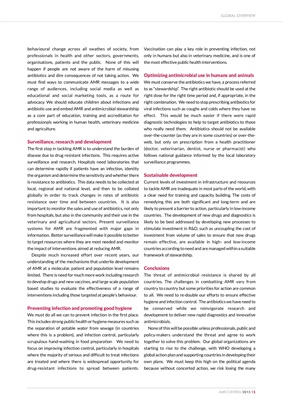
behavioural change across all swathes of society, from
professionals in health and other sectors, governments,
organisations, patients and the public. None of this will
happen if people are not aware of the harm of misusing
antibiotics and dire consequences of not taking action. We
must find ways to communicate AMR messages to a wide
range of audiences, including social media as well as
educational and social marketing tools, as a route for
advocacy. We should educate children about infections and
antibiotic use and embed AMR and antimicrobial stewardship
as a core part of education, training and accreditation for
professionals working in human health, veterinary medicine
and agriculture.
Surveillance, research and development
The first step in tackling AMR is to understand the burden of
disease due to drug resistant infections. This requires active
surveillance and research. Hospitals need laboratories that
can determine rapidly if patients have an infection, identity
the organism and determine the sensitivity and whether there
is resistance to antibiotics. This data needs to be collected at
local, regional and national level, and then to be collated
globally in order to track changes in rates of antibiotic
resistance over time and between countries. It is also
important to monitor the sales and use of antibiotics, not only
from hospitals, but also in the community and their use in the
veterinary and agricultural sectors. Present surveillance
systems for AMR are fragmented with major gaps in
information. Better surveillance will make it possible to better
to target resources where they are most needed and monitor
the impact of interventions aimed at reducing AMR.
Despite much increased effort over recent years, our
understanding of the mechanisms that underlie development
of AMR at a molecular, patient and population level remains
limited. There is need for much more work including research
to develop drugs and new vaccines, and large scale population
based studies to evaluate the effectiveness of a range of
interventions including those targeted at people's behaviour.
Preventing infection and promoting good hygiene
We must do all we can to prevent infection in the first place.
This includes strong public health or hygiene measures such as
the separation of potable water from sewage (in countries
where this is a problem), and infection control, particularly
scrupulous hand-washing in food preparation We need to
focus on improving infection control, particularly in hospitals
where the majority of serious and difficult to treat infections
are treated and where there is widespread opportunity for
drug-resistant infections to spread between patients.
Vaccination can play a key role in preventing infection, not
only in humans but also in veterinary medicine, and is one of
the most effective public health interventions.
Optimizing antimicrobial use in humans and animals
We must conserve the antibiotics we have, a process referred
to as "stewardship". The right antibiotic should be used at the
right dose for the right time period and, if appropriate, in the
right combination. We need to stop prescribing antibiotics for
viral infections such as coughs and colds where they have no
effect. This would be much easier if there were rapid
diagnostic technologies to help to target antibiotics to those
who really need them. Antibiotics should not be available
over-the-counter (as they are in some countries) or over-theweb,
but only on prescription from a health practitioner
(doctor, veterinarian, dentist, nurse or pharmacist) who
follows national guidance informed by the local laboratory
surveillance programmes.
Sustainable development
Current levels of investment in infrastructure and resources
to tackle AMR are inadequate in most parts of the world, with
a clear need for training and capacity building. The costs of
remedying this are both significant and long-term and are
likely to present a barrier to action, particularly in low-income
countries. The development of new drugs and diagnostics is
likely to be best addressed by developing new processes to
stimulate investment in R&D, such as uncoupling the cost of
investment from volume of sales to ensure that new drugs
remain effective, are available in high- and low-income
countries according to need and are managed within a suitable
framework of stewardship.
Conclusions
The threat of antimicrobial resistance is shared by all
countries. The challenges in combatting AMR vary from
country to country but some priorities for action are common
to all. We need to re-double our efforts to ensure effective
hygiene and infection control. The antibiotics we have need to
be conserved while we reinvigorate research and
development to deliver new rapid diagnostics and innovative
antimicrobials.
None of this will be possible unless professionals, public and
policy-makers understand the threat and agree to work
together to solve this problem. Our global organizations are
starting to rise to the challenge, with WHO developing a
global action plan and supporting countries in developing their
own plans. We must keep this high on the political agenda
because without concerted action, we risk losing the many
GLOBAL OVERVIEW
AMR CONTROL 2015 15